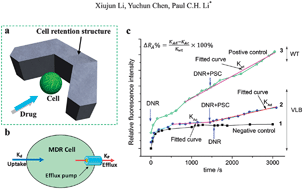A simple and fast microfluidic approach of same-single-cell analysis (SASCA) for the study of multidrug resistance modulation in cancer cells†
Abstract
Due to the cellular heterogeneity in multidrug resistance (MDR) cell populations, positive

* Corresponding authors
a
Department of Chemistry, Simon Fraser University, 8888 University Drive, Burnaby, BC, Canada
E-mail:
paulli@sfu.ca
Fax: +1 778-782-3765
Tel: +1 778-782-5956
Due to the cellular heterogeneity in multidrug resistance (MDR) cell populations, positive

 Please wait while we load your content...
Something went wrong. Try again?
Please wait while we load your content...
Something went wrong. Try again?
X. Li, Y. Chen and P. C. H. Li, Lab Chip, 2011, 11, 1378 DOI: 10.1039/C0LC00626B
To request permission to reproduce material from this article, please go to the Copyright Clearance Center request page.
If you are an author contributing to an RSC publication, you do not need to request permission provided correct acknowledgement is given.
If you are the author of this article, you do not need to request permission to reproduce figures and diagrams provided correct acknowledgement is given. If you want to reproduce the whole article in a third-party publication (excluding your thesis/dissertation for which permission is not required) please go to the Copyright Clearance Center request page.
Read more about how to correctly acknowledge RSC content.
 Fetching data from CrossRef.
Fetching data from CrossRef.
This may take some time to load.
Loading related content
